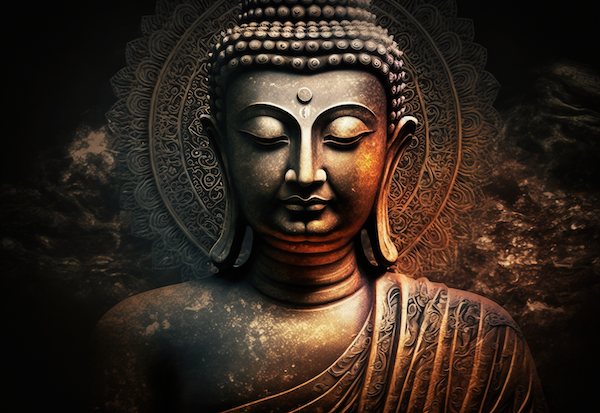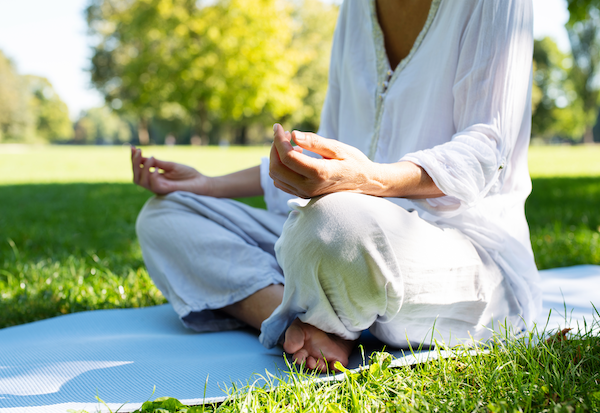
Tantric meditation is an ancient practice, derived from both Hinduism and Buddhism, that combines movement, breath, stillness, sound, and initiation to open the chakras and awaken consciousness for the purpose of liberating Shakti energy, the source of both matter and physical energy in the Indian tradition.
Despite what’s believed in the West, Tantric meditation is not just about sexuality, although it does incorporate sexual energy. It is a dynamic form of meditation that can be practiced solo or with a partner, and its goal is spiritual liberation and enlightenment. By using breathing techniques, visualization, mudras, and mantras, you can learn to tap into your own energy and connect with the divine.
The philosophy behind this practice is that everything is energy and that by learning to harness and direct that energy, you can achieve greater peace, wisdom, and empowerment. Whether you are looking to improve your meditation practice, deepen your intimacy with a partner, or simply explore your own body and desires, tantric meditation can offer a safe and effective way to do so. Stay with us if you want to explore it in this tantric meditation guide.
Table of Contents
What is Tantric Meditation?
Tantric meditation is a dynamic form of meditation. Tantra is derived from the Sanskrit, tan, meaning “expansion,” and tra, meaning “liberation.”
Tantric meditation:
- Is a technique that allows you to use energy and go deeper into yourself, experiencing enlightenment. It is a philosophy and set of practices that originated in India more than 5,000 years ago. It is a holistic approach to spirituality that integrates physical, mental, and spiritual practices to achieve a state of unity and harmony with the universe.
- Is a way to connect with the divine within yourself and in the world around you. It is a way to cultivate a deep sense of love, compassion, and understanding for yourself and others. It is a way to access the infinite wisdom and power of the universe and use it to transform your life and the lives of those around you.
- Combines movement, breath, stillness, sound, and initiation to open the chakras and awaken the Kundalini energy. It is a way to tap into your innermost self and experience a profound sense of peace, joy, and connection with the universe.
Tantric Meditation Techniques
When we were working to putting together this tantric meditation guide, the very first topic that was on the table was the techniques you can use to get started, as there are several. These techniques can help you achieve a deeper state of relaxation and connect with your inner self. Here are some of the most popular ones:
Breathwork
Breathwork is a fundamental part of tantric meditation. It involves controlling your breath to help you relax and focus your mind. One popular breathwork technique is called “pranayama,” which involves taking slow, deep breaths and holding them for a few seconds before exhaling. This technique can help you calm your mind and reduce stress.
Visualization
Visualization is another important technique that involves creating mental images to help you focus your mind and achieve a deeper state of relaxation. For example, you could visualize a peaceful scene, such as a beach or a forest, and imagine yourself there. This technique can help you reduce anxiety and improve your overall sense of well-being.
Mantras
Mantras are words or phrases that are repeated to help you focus your mind and achieve a deeper state of relaxation. In tantric meditation, mantras are often used to connect with the divine. One popular mantra is “Om,” which is believed to represent the sound of the universe. You can repeat this mantra silently to yourself during your meditation practice.
Mudras
Mudras are hand gestures that are used to help you focus your mind and achieve a deeper state of relaxation. Mudras are often used to connect with different energy centers in the body. For example, the “gyan mudra” involves touching the tip of your index finger to the tip of your thumb, which is believed to help you connect with your inner wisdom.
The Benefits of Tantric Meditation
Clarity and Wisdom
Tantric meditation can help you gain clarity and wisdom by quieting your mind and allowing you to connect with your inner self. By focusing on your breath and your body, you can learn to let go of distractions and negative thoughts and find peace and stillness within. This can help you make better decisions, and find greater meaning and purpose in your life.
Clear Difficult Emotions
Tantric meditation can also help you clear difficult emotions such as anger, fear, and anxiety. By becoming aware of your emotions, you can learn to observe them without judgment, and let them go. This can help you feel more calm, centered, and balanced, and improve your relationships with others.
Empowerment
Tantric meditation can help you feel more empowered by connecting you with your inner strength and wisdom. By focusing on your breath and your body, you can learn to access your power and tap into your intuition. This can help you feel more confident, courageous, and capable, and improve your ability to achieve your goals.
Work through Trauma
Tantric meditation can also be helpful for healing from trauma. By practicing mindfulness and becoming aware of your thoughts and emotions, you can learn to process difficult experiences and emotions in a safe and supportive way. This can help you feel more grounded, calm, and in control, and improve your overall well-being.
Awaken Sushumna
Tantric meditation can also be used to awaken Sushumna, the central energy channel in the body. By practicing specific tantric techniques such as pranayama and visualization, you can learn to activate this channel and experience greater spiritual awakening and connection. This can help you feel more connected to yourself, others, and the universe, and deepen your sense of purpose and meaning in life.
Tantra Meditation For Beginners
If you’re new to this practice, we have compiled some essential tips for beginners in this tantric meditation guide, so that you know where to start with. Remember, tantric meditation is a personal and experiential practice. Approach it with patience, openness, and self-compassion. As you continue to explore tantra meditation, you may discover profound insights, healing, and a deep connection with your inner self. Embrace the journey and allow Tantra to unfold its wisdom in your life.
Set an Intention
Start by clarifying your intention for practicing tantric meditation. Whether it’s self-discovery, spiritual growth, or cultivating inner peace, a clear intention will guide your practice.
Create a Sacred Space
Find a quiet and comfortable space where you can practice without distractions. Decorate it with items that hold meaning for you, such as candles, incense, or sacred symbols, to create a sacred atmosphere.
Center Yourself
Begin with a few minutes of conscious breathing to calm your mind and connect with the present moment. Focus on the inhalation and exhalation, allowing your breath to deepen and slow naturally.
Choose a Technique
Tantra offers various meditation techniques. Start with a simple practice like mindfulness meditation, where you observe your thoughts, sensations, and emotions without judgment. As you progress, you can explore visualization, chanting, or other advanced techniques.
Engage the Senses
Tantra emphasizes the integration of the senses in meditation. Engage your senses by incorporating gentle movements, soothing music, or aromatherapy into your practice. This helps awaken your awareness and deepen your connection with the present moment.
Cultivate Awareness
Tantra encourages embracing the full spectrum of human experience, including pleasure and discomfort. As you meditate, observe your thoughts, emotions, and physical sensations with non-judgmental awareness. Cultivate a sense of curiosity and acceptance toward whatever arises.
Seek Guidance
Consider finding a qualified tantra teacher or attending workshops to deepen your understanding and receive guidance on your tantric meditation journey. They can offer valuable insights, answer your questions, and provide a supportive community.
Tantric Meditation in Kundalini Yoga
Tantric meditation is an integral part of Kundalini yoga practice. It combines movement, breath, stillness, sound, and initiation to open the chakras and awaken the Kundalini energy that lies dormant at the base of the spine.
The word Tantra translates to loom, warp, or weave, referring to a specific instructional text, often presented as a dialogue between a god and goddess. Tantric meditation aims to unite the individual soul with the universal soul, and the practice is grounded in the belief that the Divine Mother is the highest reality.
In Kundalini yoga, the Kundalini energy rises from the base of the spine, Muladhara (the root chakra), up to Sahasrara (the crown chakra). In between, there are five more chakras, namely Swadhisthana, Manipura, Anahata, Vishuddhi, and Ajna. Tantric meditation aims to awaken and balance these chakras, leading to a state of inner peace, clarity, and spiritual growth.
During a tantra session, you may be guided to chant mantras, perform specific mudras (hand gestures), or practice pranayama (breathing exercises). The practice may involve sitting in stillness or moving through a series of postures. The focus is on directing the Kundalini energy through the chakras, clearing blockages, and awakening the dormant potential within.
Tantric Meditation and Sexuality
Tantric meditation is a practice that can help you connect with your body and mind in a more profound way. It can also help you tap into your sexual energy and improve your overall sexual experiences.
The focus is on cultivating awareness and mindfulness, which can help you become more present in the moment and more attuned to your body’s sensations. By learning to be more present and mindful during sex, you can deepen your connection with your partner and experience more pleasure.
One of the key principles is the idea that sexual energy is a powerful force that can be harnessed for personal growth and spiritual development. By learning to channel this energy through meditation and other practices, you can increase your vitality, creativity, and overall well-being.
In the context of tantric sex, meditation can be used to enhance sexual experiences and deepen intimacy. By practicing mindful breathing and other techniques during sex, you can increase your awareness of your body’s sensations and become more attuned to your partner’s needs and desires.
Tantric Meditation and Modern Life
In today’s fast-paced world, finding peace and balance can be a challenge. Tantric meditation is a powerful tool that can help you connect with the present moment and cultivate a sense of inner harmony. Here are some tips for incorporating it into your modern life:
- Create a comfortable environment: Find a quiet space where you can sit comfortably without distractions. Dim the lights, light candles, or burn incense to create a relaxing atmosphere.
- Engage your senses: Use aromatherapy, soothing music, or soft fabrics to stimulate your senses and create a calming environment. This will help you relax and focus on your meditation practice.
- Be active: Unlike other forms of meditation, tantric is an active practice that involves movement, breathwork, and visualization. Incorporate gentle yoga poses or other movements to help you connect with your body and release tension.
- Improve performance: By cultivating mindfulness and awareness, you can become more present and focused in your daily activities.
- Experience safe orgasms: By practicing control and awareness, you can learn to channel your sexual energy in a positive way and avoid anxiety or discomfort.
- Manage anxiety and desire: By learning to observe your thoughts and emotions without judgment. This can help you develop a more balanced and mindful approach to life.
Before you go…
Incorporating tantric meditation or tantric yoga into your daily routine can be a life-changing experience, regardless of whether you are a beginner or an experienced meditator. We hope this tantric meditation guide has been useful to you!
Tantric Meditation is just one of the many ways yoga and meditation can positively impact your well-being. We recommend you check these other articles:
- Tantric Hatha Yoga: Discover The World of Self-Love and Understanding
- Kundalini Tantra Yoga: A Comprehensive Guide, Benefits and Precautions
- Candlelight Restorative Yoga: A Guide to Relaxation and Renewal
Namaste!



